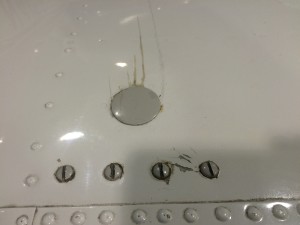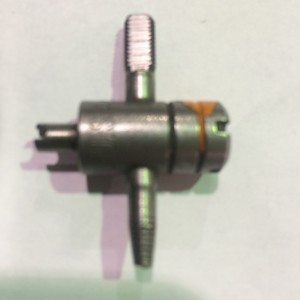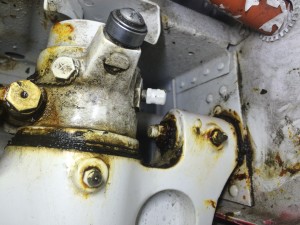Podcast: Play in new window | Download
Note: After reading this, if you’d like to learn exactly how to service a shock strut with fluid and nitrogen, check out this video training course:
Click here to check out the step-by-step video training course.
February 5, 2016
Servicing landing gear shock struts… can you do it as an airplane owner?
Absolutely! Just take a look at the list of items in Part 43, Appendix A.
However, MAKE SURE you are familiar with the procedure before you launch into on your own.
Why? Because servicing landing gear shock struts can be both messy and dangerous, if not done properly.
(Both Bogert Aviation and Aircraft Spruce have some cool strut servicing equipment, but it can be a little pricey.)
If you want to learn more about an airplane strut, you can go to this link and read an excellent article by Mike Busch, with Savvy Aviator. I find his articles to be very educational and helpful.
http://www.avweb.com/news/savvyaviator/192153-1.html

Notice the seepage on top of the wing, coming from the plug that covers the Schrader valve for servicing the shock strut.

This is a simple tool for removing and tightening the valve core in the Schrader valve. Before adding air or nitrogen to a strut that is low, it’s a good idea to verify the core is tight. (You can buy this tool at an auto parts store, or even Walmart,)
In the case of the above strut, I found the Schrader valve itself needed a little tightening (with a wratchet and 3/4 inch socket.)
Listen to the audio to hear the rest of this story.
Here is a typical nosestrut on a Beech Bonanza. Notice the Schrader valve (servicing valve) with the white cap in the center of the picture. This is where fluid and nitrogen are added to the strut.
In today’s episode we’ll answer these questions:
- What type of landing gear do you have on your airplane?
- If you have an oleo (air-oil) strut, how do you know if it needs servicing?
- Does your strut need air/nitrogen, or oil (aviation hydraulic fluid,) or both?
- When does your strut need more maintenance than just “servicing?”
- What tools and equipment will be needed?
- What is the procedure for “servicing” a shock strut?
- What are some cautions to be aware of?
- What can happen if you ignore the condition of your shock struts?
So, after listening to today’s episode, I would encourage you to do the following if you have an airplane with one or more shock struts:
- Take a look in your POH or Owners Manual, and find the recommended inflation setting for your shock struts (typically in inches of extension, but can also be in psi with no load on the strut. This information will typically be in the chapter on servicing.
- Measure the extension levels on your struts and see if they meet the specs. While you do this, dampen a cloth with a little avgas, and clean the chrome shaft on the shock strut. This will help prevent any dirt or other debris from getting in the sealing area as the shaft moves up and down inside the strut housing.
- If your strut needs servicing, get some help the first time from someone with experience, and go for it!
- Make it a part of your preflight inspection, to verify your struts are at the proper level, have no fluid leakage, and that the strut shaft is clean.
One final tip for enjoying this podcast, or any podcast for that matter! (You’ll have to listen to find out what this is!)
And please… if you enjoy this podcast and want it to continue, let a few of your aviation friends know about it, and rate the podcast in iTunes. (You can also find it in Stitcher, if you prefer that.)
Also, PLEASE leave a comment below and let me know any future topics you would like to hear about. Or, you can send me an email at deanshow@gmail.com





I have enjoyed all of your podcasts so far. Thank you for sharing your knowledge. My partner and I own a 1995 Saratoga HP. We just participated in our second owner assisted annual last month. Both have been an excellent learning experience. I am interested in a future podcast topic about taking engines past TBO. We are at aprox 1870hrs since TBO, 2900TT. Engine was replaced by Lycoming remanufacture at 1000 hrs secondary to a lightening strike on the ground. I have read Mike Busch’s Manifesto a couple times. We change our own oil every 35-40 hrs, oil sample is sent and filter cut. Compressions were all 78/80. Borescope was good. We have a few oil leaks as expected for engine of these hrs. We use a quart of oil about every 9-10 hrs. The engine runs great. Thanks, Lance
Thank you Lance! I really appreciate the feedback. I will definitely put your request on my list for a future episode.
The Saratoga is a great airplane… we maintain a fair number of those in the shop where I work. If you’re ever in the Shenandoah Valley of Virginia, stop in and say hi!
Yet another excellent podcast. Before listening to this, I had assumed that you always inflate the nose gear strut when you start seeing less chrome (on the trainer 172 I was instructed to look for “three fingers” of chrome during my pre-flight checks), and wasn’t aware of the importance of the compression ratio between the static and compressed positions of the strut – The test of rocking the nose up and down to evaluate “springiness” and to also look for leaks makes sense and I’m glad that I am now aware of the importance of knowing whether it is an issue of requiring more hydraulic fluid or nitrogen. You mentioned using compressed air or nitrogen at the beginning, and talked about nitrogen thereafter. What are your thoughts on using compressed air instead of nitrogen?
Thank you again for granting my topic requests and I look forward to the next podcast!
Thanks for the question about air vs. nitrogen. Nitrogen is considered the best option, since it is free of moisture. Compressed air will work fine if it is dry. Also, nitrogen bottles typically hold appoximately 2000 psi, whereas air compressors may be set to about 120 psi. So the nitrogen bottle is much more capable of adding a bit of pressure in a strut without putting the airplane on jacks.
Thanks so much for a great podcast! I just discovered your ‘cast a few days ago and have listened to several already. I own a 1986 Piper Archer, and just got through with the drama of pulling the fuel tanks and looking inside the wings. Luckily my spars got a clean bill of health. I really wish I’d heard your episode about servicing struts before I attacked my nose strut with a nitrogen bottle and ended up with the nose pointing high in the air! I’m really looking forward to catching up on the back episodes and hearing new ones.
Thanks Eric, for all your feedback! I really appreciate knowing the episodes are helping airplane owners out there. So happy to hear your spars were clean. The Archer is a great airplane… we’ve worked on a few of those over the years.
Thank you so much for your podcast on oleo struts. I have a Cessna 150 and was trying to see if I could add air instead of nitrogen. Doesn’t appear to be leaking but with the winter weather it needs a little air/nitrogen now that it is Spring. Thanks also for the safety warnings. I will tie the back down on the tarmac to take pressure off of it.
My pleasure… I’m glad you found it helpful.
“2. Measure the extension levels on your struts and see if they meet the specs. While you do this, dampen a cloth with a little avgas, and clean the chrome shaft on the shock strut. This will help prevent any dirt or other debris from getting in the sealing area as the shaft moves up and down inside the strut housing.”
I would not recommend using avgas on the chrome shaft of the strut. The internal seals of the oleo strut are not designed/manufactured for use with avgas, hydraulic fluid only.
Avgas will cause the gaskets to breakdown which will lead to the seals failing in the future.
The rag should be dampened with the proper hydraulic fluid that the oleo strut is serviced with, then use that rag to clean the chrome portion of the strut.
I know the maintenance manual recommends the procedure you described. However, Avgas works much better than hydraulic fluid, to clean the strut shaft. There is typically a snap ring and a scraper ring below the seal, so it’s unlikely the Avgas used on a cloth for cleaning, would even touch the rubber seal inside the strut. Another reason I don’t like to use hydraulic fluid on the chrome shaft, is because of the potential for collecting dust and dirt. Thanks for your thoughts!
Thank you for the useful information. I have a PA28-161 and noticed one of the struts is higher (5+ inch) than the other (4 inch), both inside the recommended values 4.5 +- .5 but a 1.5 inch difference.
Mechanic shown me other PA28 that look the same and explained is a normal issue. He also pushed the higher wing to show me the strut compress and returns to its possition. I tested hard landings on that side and bounce a lot. I was thinking, and correct me if wrong, to remove the strut cap and let some air/nitrogen release to see if the strut loses .5 inch at least. Do you think that is smart to do it or better adding more air to the shorter strut?
If one strut is more than 5″ then it would make sense to let a little pressure out. Also, sometimes the seals inside the strut get old and hard, and the strut does not move freely up and down. In this case, it might help to install new seals in the bottom of the strut, and service with fresh hydraulic fluid and nitrogen.
Hello,
Thank you for your great podcast.
I own a 1966 Piper Cherokee 180, would you happen where I could buy a main gear tube? Mine are pitted and will need replacement soon.
Thanks,
Anthony
Your welcome! Do some research for a good used one, or ask around in the forums and Facebook groups.